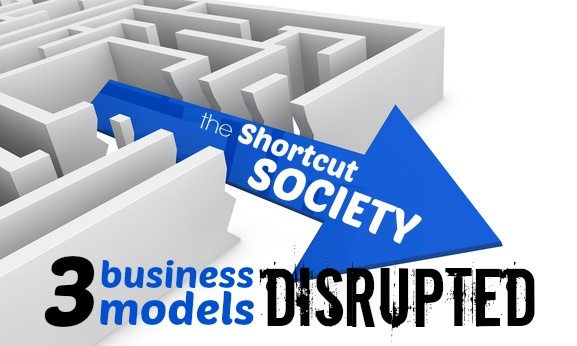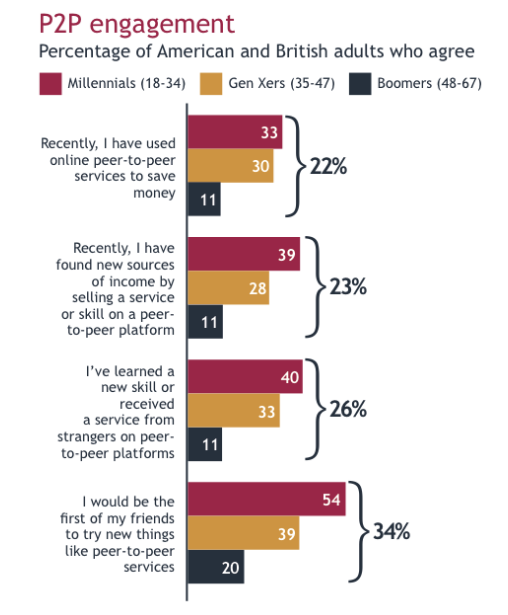3 BUSINESS MODELS DISRUPTED BY THE MILLENNIAL SHORTCUT SOCIETY TREND [GUEST POST]
There is one thing we can agree on: Millennials have been taught all their lives to make as little effort as possible yet to find and reach what they want when they want it in a way that suits them best. They have grown up with a rather natural ‘shortcut reflex’.
Older generations sometimes wrongfully mistake them for being idle. However, there is not one single reason why we should make a detour. Yet we do so every day, because we were taught it wrongly, because we have been conditioned differently. So we do it out of habit or because there are rules, trainings, and legislations which keep us from taking shortcuts.
In this post we take a look at the trend called the ‘shareconomy’ (or what trendwatcher Sven Mastbooms calls the ‘shortcut society’) which is embraced by Generation Y.
The access to information, technology, money, and kindred spirits (peers) has been largely facilitated by social media and sharing. Just think about how P2P networks have done damage to the music, TV, and movie business. In 2014 and in several sectors, we will see an endless flow of new peer-to-peer and shortcut initiatives which – based on the Millennials’ passion – will rock the boat of several classic sectors.
Existing business models will get under pressure as a result of the Gen Y consumers’ urge to take a quicker, easier, cheaper and less strenuous shortcut to the solution.
Shortcut Economy In The Education Sector
The so-called MOOCs (Massive Online Open Courses) such as Khan Academy, a non-profit educational website providing free world-class education for anyone anywhere through a video library and over 100,000 practical exercises. Other examples include: eDX, Coursera, and Coderdojo, coaching youngsters aged 7 to 18 to learn how to code in a cosy club context, stressing the usage of open-source free software.
Shortcut Economy In The Mobility Sector
Lyft is a cellphone application which allows users to “order” a driver to their location in minutes. During their ride, passengers can play their own music and charge their mobile devices. All drivers are subjected to a criminal background check as well as a vehicle inspection and a two-hour training session. At the end of the trip, passengers pay the driver the amount of their choice in the form of a (technically optional) donation. Because Lyft facilitates pre-arranged travel instead of on-the-street taxi-hailing and operates on a donation system, its drivers do not need a taxi license. Although payment is not guaranteed, the majority of Lyft users are willing to pay the drivers a satisfactory rate.
Other examples:
- Uber app, already active in 22 countries and 60 cities, offering cheap car loans to drivers (financial services), might start other services such as sharing/renting your equipment in cities (e.g. barbecues). Google is one of the investors and according to NYMag, Uber is already valued higher than Facebook and Twitter because it is profitable and does not depend on an ad revenue business model.
- FlyKly smart wheel: why buy a new bicycle if all you need is an electric wheel which can be installed on any bike? Engine, batteries, a GPS chip and electronic lock are integrated in the wheel axle. The related app gives wheel and battery information as well as statistics on cycling style, itineraries etc. The GPS chip is connected to the cycling computer functions and suggests shorter and safer new routes, find-my-bike and of course route sharing with the FlyKly community.
- Other initiatives include BlaBla Car, Spinlister, Getaround, Side-car, Boatbound, Flightcar, Jumpseat
Shortcut Economy In The Travel Sector
Generation Y is the fastest growing customer segment in the travel industry. They are expected to finance half of all travel spending by 2020. Millennials are adventure seekers. Millennials want a great place to stay and an experience which fits with them, not an unpersonal treatment in an anonymous environment.
The industry has already created some new travel experiences that tap into this trend, such as portable container hotels that allow guests to stay in more off-the-beaten-track locations (e.g. Sleeping Around, Sleepbox Hotel). Peer-to-peer lodging companies are challenging traditional hotels. Generation Y is simply more accustomed to networking with and trusting peers as illustrated by the following 2013 data (see graph below).
Question: How do you see the “shortcut society” disrupting other sectors?
About the Author: Joeri Van den Bergh is the co-founder of InSites Consulting, a global ‘new generation’ research agency with offices in Belgium, the United Kingdom, France, Switzerland and the Netherlands. He has extensive experience of all aspects of branding, marketing and advertising to kids, teens and young adults. His clients include global customers such as Lego, Nokia, Sony, MTV Networks, Danone, Unilever and Coca-Cola, for whom he has provided research and advice on how to target the youth market. As author and contributor to numerous jounals, he also lectures throughout the world on marketing topics.
This article originally appeared on HowCoolBrandsStayHot.com and has been republished with permission.



